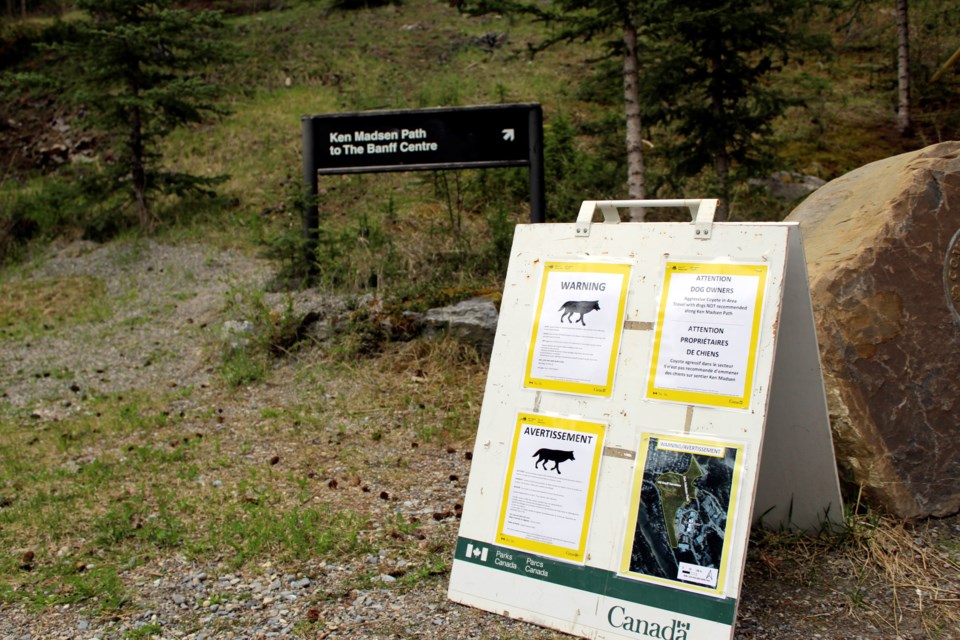BANFF – Wildlife are reclaiming areas in Banff National Park that are typically overrun with people.
Nature has moved into once busy places all over the world during the COVID-19 lockdown, from humpback whales in the St. Lawrence River near Montreal, to puma in the streets of Santiago, Chile. In Banff, some wildlife behaviour this spring is prompting closures.
“We have foxes and coyotes denning and birds nesting in areas where they wouldn’t normally be perhaps,” said Bill Hunt, resource conservation manager for Banff National Park.
“Wildlife are incredibly sensitive to changes in the environment, and as as soon as we change our human use patterns, wildlife detect that right away. We are asking people to respect these closures, so we can protect wildlife.”
An aggressive coyote has prompted a warning for an area near the Old Banff Cemetery, including the Ken Madsen Path and other nearby trails.
Hunt said a coyote approached people with dogs. In one case, the coyote nipped at a dog and in another sniffed a dog from behind.
“That’s really typical behaviour we see when they are trying to defend a den site,” said Hunt, noting the den has not been located yet.
“Typically, we’ll see a coyote doing that when they’re trying to set up territory over an area that they’ve staked out for a den site.”
A killldeer nesting on the ball diamonds at the Banff recreation grounds has prompted a closure of that area.
“I don’t think she would have selected that place if it had had normal levels of human use there,” said Hunt, adding the killdeer is currently incubating eggs.
“She’ll be super stressed if you’re close so we’ve set up a closure so that we don’t put her in that situation.”
Although killdeer are classified as a shorebird, they like to nest in open areas, including fields and pastures where there are good sight lines. Their nests blend marvellously into the background.
“They totally rely on their camouflage and you can be standing two feet away from a killdeer nest and not see it,” said Hunt, noting the eggs also blend into the environment.
“She’ll hold and hold and hold on the nest until the last second, so it’s really easy to step on the nest or a chick.”
The closure, which includes the Bourgeau and Sulphur ball diamonds, including bleachers and seating, is likely to remain in place for about another three weeks.
“Then she would typically move the chicks off to a marshy area or something like that,” said Hunt.
Nesting loons have led to a closure over the past week of an area at the north end of Third Vermilion Lake. This closure, which goes into place each spring, aims to protect the birds from human disturbance.
However, another closure was put in place on Monday (June 1) to protect nesting loons at the Two Jack day use area peninsula. The Minnewanka loop has been off limits to vehicles from March 26 to June 1, when human use was drastically reduced.
“The closure at Two Jack is very unusual. We haven’t seen them there as far as I can remember,” said Hunt.
“Loons are fairly easily pushed off the nest and that leaves the eggs vulnerable to predation.”
There’s another closure in place in the Lake Minnewanka area due to fox activity.
Hunt said wildlife are continually assessing and sampling their environment.
“It’s critical to their survival in every way, shape or form for cover, for food, for breeding, for feeding opportunities,” he said.
A 2019 study published by Parks Canada in the journal Scientific Reports showed wolf use almost doubles when the eastern end of the Bow Valley Parkway is closed overnight each spring.
Hunt said that study highlighted how animals change behaviour when levels of disturbance or displacement change.
“That’s a situation where we did something very purposefully and set up a study design, studied the results and published a paper,” he said.
“What we’re seeing this summer is sort of opportunistic examples similar to that, where through COVID, there’s reduced levels of human use in the park,” he added.
“Wildlife are taking advantage of those opportunities to seek out and occupy new habitats within the park.”



